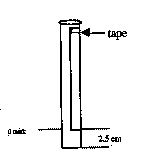Grade 5-8 Performance Task
Contributed by: New York State Education Department (NYSED)
NYS Alternative Assessment in Science Project (1996)
Description:
Students will measure the rate of sinking of a test
tube into a beaker of "glop", representing a model of
the interaction between the Earth's crust and upper mantle.
This task assesses students' abilities to make simple
observations, collect, record, and represent data, use a graph
to represent data, relate the model to their knowledge of geologic
processes, infer from the model why this geologic process occurs,
and describe other factors not addressed by the model.
This task is designed to take students approximately
25-30 minutes to complete.
Overall Task Content Area:
Specific Knowledge Areas:
Structure of the Earth System
Performance Expectations:
- conducting investigations
- using equipment
- gathering, organizing, and representing data
- formulating conclusions from investigational data
- applying scientific principles to develop explanations and solve
new problems
National Science Education Standards:
8 ASI 1: Abilities necessary to do scientific inquiry
1.3 Use appropriate tools and techniques to gather, analyze,
and interpret data. The use of tools and techniques, including mathematics,
will be guided by the question asked and the investigations students
design. The use of computers for the collection, summary, and display
of evidence is part of this standard. Students should be able to
access, gather, store, retrieve, and organize data, using hardware
and software designed for these purposes.
1.4 Develop descriptions, explanations, predictions, and
models using evidence. Students should base their explanation on
what they observed, and as they develop cognitive skills, they should
be able to differentiate explanation from description Ñ providing
causes for effects and establishing relationships based on evidence
and logical argument. This standards requires a subject knowledge
base so the students can effectively conduct investigations, because
developing explanations establishes connections between the content
of science and the contexts within which students develop new knowledge.
8 D ESS 1: Structure of the earth system
1.2 Lithospheric plates on the scales of continents and
oceans constantly move at rates of centimeters per year in response
to movements in the mantle. Major geological events, such as earthquakes,
volcanic eruptions, and mountain building, result from these plate
motions.
(Use the "hot" link on the PALS home
page to check the full text of related National Science Education
Standards, if desired.)
National Council of Teachers of Mathematics:
Algebra (AL1): Understand patterns, relations and functions.
Algebra (AL4): Analyze change in various contexts.
Data Analysis and Probability (DAP3): Develop and evaluate
inferences and predictions that are based on data.
Problem Solving (PS2): Solve problems that arise in mathematics
and in other contexts.
Representation (REP1): Create and use representations
to organize, record, and communicate mathematical ideas.
General Instructions to the Teacher:
This task is designed to take approximately 25-30 minutes to complete.
Students will be working individually during this exercise.
Students should be ready to work as soon as the period begins.
The materials should be set out at each lab station, if possible.
A central supply area, if needed, should be easily accessible. All
supplies should be clearly labeled.
Materials for "Crustal Sinking":
The teacher will need:
- prepare "Glop"
- (store in sealed bags)
- prepare calibrated test tubes
- clear tape
At each station students should have:
- 250 ml beaker containing "Glop"
- ring stand
- test tube clamp
- test tube with scale
- timer
Advance Preparation:
Recipe for "Glop"
- Dissolve 75 ml Borax in one liter of water and set aside.
- Mix equal parts of white glue and water.
- ***Do not use the fluorescent Elmer's Glue. It is not always
successful
- Add food coloring to the glue mixture.
- Combine the glue mixture and the Borax mixture in a 3:1 ratio.
- Mix until the glop has the consistency of Silly Putty.
- A more concentrated solution of Borax will give you a stiffer
mixture.
- One 200-250 ml beaker is approximately 65 ml of borax solution
and 190 ml of glue mixture for each station.
- Store the glop in an airtight container.
- Refrigerate in sealed plastic bags for long-term storage.
| |
To prepare calibrated test tube:
|
 |
- Make a transparency of the metric ruler from the Earth
Science reference tables (cut to fit test tube used).
- Insert the metric ruler inside test tube to have the zero
mark 2.50 cm above the bottom of the test tube (refer to
diagram).
- Tape transparency to inside of test tube. (These are now
ready for use and can be stored for future use.)
|
Safety:
- The glop mixture contains Borax, which is poisonous if ingested.
If this material is accidentally eaten, call the poison control
center immediately.
- Borax is also an eye irritant. Eyes that may have been contaminated
with glop should be flushed with water immediately.
- Students should be cautioned and instructed to wash hands after
the task.
- Be careful.
- Teachers and students should always exercise appropriate safety
precautions and utilize appropriate laboratory safety procedures
and equipment when working on science performance tasks.
Extensions/Modifications:
- You may change the consistency of the glop to produce different
sets of data. You may vary the rate of crustal sinking by varying
the type of substances placed inside the test tube.
|


